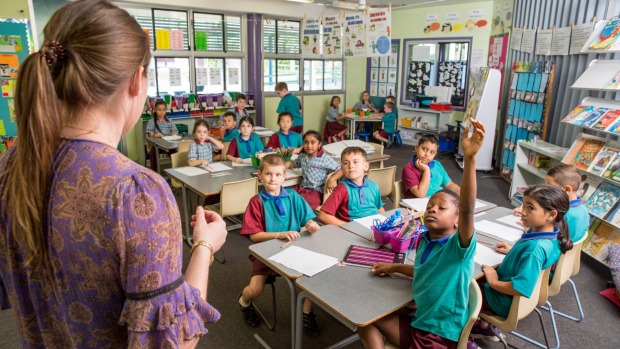Oceanía/Australia/Junio 2016/Autor: Tim Dodd / Fuente: afr.com
Resumen: Un movimiento político para aumentar el tamaño de clases en las escuelas (cantidad de estudiantes por aula) por no más de dos estudiantes ahorraría más de $ 1.5 mil millones al año, lo suficiente como para financiar la promesa electoral de Trabajo de $ 4.5 millones de dólares de la escuela en el próximo período de gobierno, sin dañar los estándares educativos.
A politically-bold move to increase class sizes in schools by no more than two students would save over $1.5 billion a year, enough to fund Labor’s $4.5 billion school’s election promise in the next term of government without harming educational standards.
But on Friday both sides of politics ducked the issue of class sizes with Labor’s education spokesperson Kate Ellis and Education Minister Simon Birmingham saying class sizes were a matter for state governments.
If Labor was willing to push for reduce class sizes it could fund its school election promise without increasing government debt. Similarly the Coalition could use smaller class sizes to find the money to prove its contention that effective school reforms can be made without the major boost to school funding promised by Labor.
The Australian Financial Review reported this week that Australia’s dramatic cut in school class sizes over the past five decades had led to a 25 per cent increase in school funding while school standards deteriorated.
Education experts said a small increase in class size was a reform worth considering because it would free up time to allow teachers to improve their skills and introduce teaching methods which are proven to work.
Catholic schools, which already have larger than average class sizes, said that they did not affect education standards.
«We believe – and the research supports the view – that the greatest impacting factor on student achievement is teacher quality,» a spokesman for the Brisbane Catholic Education Office said.
He said there was no deliberate trade-off in the Catholic system to opt for larger classes to fund other schooling priorities.
«Catholic schools are the most efficient managers of financial resources of the three educational sectors, but this is not at the expense of academic performance,» he said.
However private schools and the teacher’s union defended smaller class sizes saying they allowed teachers to support students individually.
The chief executive of the Association of Heads of Independent Schools of Australia, Beth Blackwood, said the smaller class sizes in private schools enabled the schools to deliver important non-educational outcomes to students.
There’s a capacity for teachers to give individual attention and get to know students. Parents are looking for that individual attention for the pastoral side of education,» she said.
The federal president of the Australian Education Union, Correna Haythorpe, agreed. «Small class sizes are vital because we need to ensure that teachers are able to provide individual support to students who need it,» she said.
Ms Haythorpe said that schools also needed Gonski funding to allow them to choose which strategies to improve education outcomes suited them best.
Australia’s student-teacher ratio fell from 25-to-1 in 1964 to 14-to-1 in 2015, adding more than 25 per cent to the cost borne by government for school education. While most of the fall occurred in the 1960s and 1970s, the ratio has continued to drift downwards in the last 15 years.
Analysis by The Australian Financial Review shows that a 5 per cent productivity increase in the student-teacher ratio in Australian schools (currently 13.9) would lift the student teacher ratio back to its 2002 level of 14.6 and save about $1.6 billion a year from the teacher salary bill.
The average class size, currently 24 (which is larger than the student-teacher ratio because of time spent by teachers on other duties) would rise by no more than two students per class.
According to the Productivity Commission Australian governments (both federal and state) spend $50 billion a year on schools and that 64 per cent of funding of government schools goes to teacher salaries. This means about $32 billion of government school funding is spent on teacher salaries and a 5 per cent productivity improvement would save $1.6 billion.
Fuente de la noticia: http://www.afr.com/leadership/innovation/larger-classes-would-free-15-billion-a-year-to-improve-schools-20160603-gpb0wm
Fuente de la imagen: http://www.afr.com/content/dam/images/g/p/b/c/6/p/image.related.afrArticleLead.620×350.gpb0wm.png/1464943421979.jpg










 Users Today : 4
Users Today : 4 Total Users : 35460891
Total Users : 35460891 Views Today : 8
Views Today : 8 Total views : 3420198
Total views : 3420198